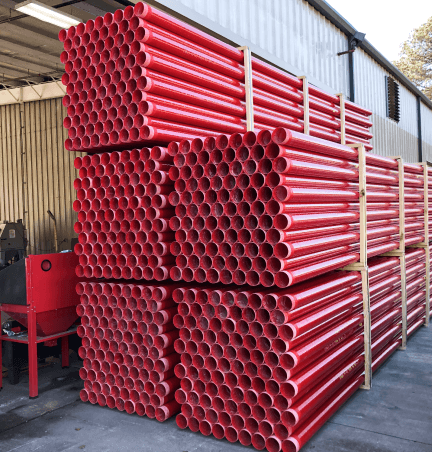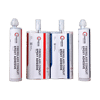The field is busy-but there’s only one spot for number one. See how fiberglass conduit stacks up to the competition in crucial areas like weight, corrosion resistance and installation cost.
EPOXY FIBERGLASS | PVC SCH 40 | PVC SCH 80 | GALVANIZED RIGID STEEL | PVC COATED STEEL | ALUMINUM |
||
|---|---|---|---|---|---|---|---|
Cable FaultFiberglass conduit will not melt or weld the wire to the inside of the conduit under fault conditions as can happen with PVC, steel and aluminium conduit. | Not Affected | Melt/Fuse | Melt/Fuse | Weld | Weld | Weld | |
Toxicity/HalogensFiberglass conduit does not release toxic halogens (i.e. chlorine and bromine) when burning. | No | Yes | Yes | No | Yes | No | |
| WEIGHT COMPARISON (SW IPS – lbs./per 100 ft., approx.) Fiberglass conduit offers the lowest weight and is still very rigid. | 3 ⁄ 4“ | 17 (SW) | 23 | 29 | 105 | 105 | 36 |
| 1″ | 19 (SW) | 34 | 43 | 153 | 153 | 53 | |
| 11 ⁄ 4“ | 23 (SW) | 46 | 59 | 201 | 201 | 70 | |
| 11 ⁄ 2“ | 33 (SW) | 55 | 99 | 246 | 246 | 86 | |
| 2″ | 38 (SW) | 73 | 99 | 334 | 334 | 116 | |
| 21 ⁄ 2“ | 46 (SW) | 125 | 152 | 527 | 527 | 183 | |
| 3″ | 60 (SW) | 164 | 212 | 690 | 690 | 239 | |
| 31 ⁄ 2“ | 65 (SW) | 198 | 262 | 831 | 831 | 288 | |
| 4″ | 72 (SW) | 234 | 310 | 982 | 982 | 340 | |
| 5″ | 120 (MW) | 318 | 431 | 1344 | 1344 | 465 | |
| 6″ | 142 (MW) | 412 | 592 | 1770 | 1770 | 612 | |
Temperature Range (°F)Fiberglass has an excellent wide temperature range. | -40° to +230° | +40° to +150° | +40° to +150° | N/A | N/A | N/A | |
Handling in Low TemperaturesFiberglass conduit has been shown to retain its properties at low temperatures allowing year round installations. | Excellent | Brittle | Brittle | Excellent | Excellent | Excellent | |
CURRENT NEC, PVC & RTC SPACING | CHAMPION FIBERGLASS UL-LISTED SUPPORT SPANS | CHAMPION FIBERGLASS UL-LISTED SUPPORT SPANS | CHAMPION FIBERGLASS UL-LISTED SUPPORT SPANS | CHAMPION FIBERGLASS UL-LISTED-XW SUPPORT SPANS | GRC, PVC-COATED & ALUMINUM SPACING |
||
|---|---|---|---|---|---|---|---|
SW | MW | HW | |||||
SUPPORT SPANSChampion Fiberglass support spans are UL listed. Conduit listed for support spacing other than shown in National Electrical Code (NEC) Table 355 shall be permitted to be installed in accordance with the UL listing. | 3 ⁄ 4“ | 3 ft. | 10 ft. | – | – | 10 ft. | 10 ft. |
| 1″ | 3 ft. | 10 ft. | – | – | 10 ft | 12 ft. | |
| 11 ⁄ 4“ | 5 ft. | 10 ft. | – | – | 15 ft. | 14 ft. | |
| 11 ⁄ 2“ | 5 ft. | 10 ft. | – | – | 15 ft. | 14 ft. | |
| 2″ | 5 ft. | 12 ft. | – | – | 15 ft. | 16 ft. | |
| 21 ⁄ 2“ | 6 ft. | 12 ft. | – | – | 15 ft. | 16 ft. | |
| 3″ | 6 ft. | 12 ft. | – | – | 17 ft. | 20 ft. | |
| 4″ | 7 ft. | 12 ft. | – | 14 ft. | 17 ft. | 20 ft. | |
| 5″ | 7 ft. | – | 13 ft. | 14 ft. | 17 ft. | 20 ft. | |
| 6″ | 8 ft. | – | 13 ft. | 14 ft. | 17 ft. | 20 ft. | |
Features & Advantages
EPOXY FIBERGLASS | PVC SCH 40 | PVC SCH 80 | GALVANIZED RIGID STEEL | PVC COATED STEEL | ALUMINUM |
||
|---|---|---|---|---|---|---|---|
BURN THROUGH (CABLE PULL)Fiberglass conduit is an excellent material for avoiding “burn through” when pulling cable. | No | Yes | Yes | No | No | No | |
COEFFICIENT OF FRICTIONUsing PVC Jacketed Cable | 0.38 | 0.90 | 0.90 | 0.55 | 0.55 | 0.25 | |
CONDUCTIVITYFiberglass conduit acts as an excellent insulator. | No | No | No | Yes | Yes | Yes | |
UV STABLE (SUNLIGHT RESISTANCE)(Per UL 2515 & CSA C22.2 No. 211.3-96) | Good | Poor | Poor | Excellent | Poor | Excellent | |
COEFFICIENT OF THERMAL EXPANSION | 1.5 | 3.4 | 3.4 | 0.65 | 3.4/0.65* | 1.3 | |
DISTANCE BETWEEN EXPANSION JOINTS (FT) | 200 | 50 | 50 | 200 | 200 | 50 | |
NECA LABOR INSTALLATION RATES(Normal installation hours per/100 ft) (REF: 2019-2020 NECA Manual of Labor Units) *Reduce labor units by 10% for 20-foot lengths | 3 ⁄ 4“ | 5.5 | 4.5 | 5.4 | 6.0 | 8.0 | 5.5 |
| 1″ | 5.8 | 5.3 | 6.3 | 7.0 | 10.0 | 6.0 | |
| 11⁄4“ | 6.0* | 6.0 | 7.2 | 8.0 | 12.0 | 6.5 | |
| 11⁄2“ | 6.4* | 7.0 | 8.4 | 9.0 | 15.0 | 7.0 | |
| 2″ | 6.8* | 8.0 | 9.6 | 11.0 | 18.0 | 8.0 | |
| 21⁄2“ | 7.1* | 9.0 | 10.8 | 15.0 | 21.0 | 10.0 | |
| 3″ | 7.5* | 10.0 | 12.0 | 20.0 | 26.0 | 12.0 | |
| 31⁄2“ | 7.9* | 12.0 | N/A | 25.0 | 32.0 | 15.0 | |
| 4″ | 8.3* | 14.0 | 16.8 | 30.0 | 38.0 | 19.0 | |
| 5″ | 8.6* | 18.0 | 21.6 | 38.0 | 45.0 | 24.0 | |
| 6″ | 9.0* | 24.0 | 28.8 | 48.0 | 60.0 | 30.0 | |
FIELD HANDLINGDue to its light weight, ease of cutting and integral bell, fiberglass conduit is very easy to install. | Excellent | Good | Good | Very Poor | Very Poor | Poor | |
MEMORYFiberglass conduit will retain its original shape after impact or compression. | Yes | No | No | No | No | No | |
Visit the conduit calculator to get an estimate.












